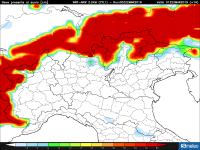Hi, I'm running some simulations using WRF V4.0.3 on Northern Italy. We use ECMWF data initialization and the domain resolution is 4km (in reality we run a 2.2km horizontal resolution domain all over Italy for operational use, we made those 4km simulations only for testing the impact of pbl and lsm physics on certain conditions). We use Corine Landuse and Aster Gdem v2 orography.
When using ACM2 PBL with Noah LSM togheter, we find a HUGE cold bias during night time on 2m temperatures on Alps. It seems to be related to snow depth init from ECMWF, which appears too coarse and high.

Above are shown 2 simulations, one with snow from ecmwf init, the other with snowh, snowc and snow setted to 0 in wrfinput file from real. The huge bias disappears, while the good performances on the Po Valley with nighttime temperature inversion are not touched.

If we run a third simulation using Noah-MP LSM with ACM2, the snow cover on Alps is much better tratted respect to the simulation with Noah LSM and Snow from Ecmwf in wrfinput... but on the other hand, we lose the good performance on temperature inversion in the Po Valley. We also observed better performances on maximum 2m temperatures on Po Valley when using Noah LSM and ACM2.
The run with ACM2 PBL and Noah LSM appears very unstable too, for sure because of the snow tratment on Alps (often the run without snow in wrf input end successfully while the run with ecmwf snow depth init data fails).
Has anyone encountered this kind of problem? Is it possible to treat albedo better on complex orography using Noah LSM? Thank you!
PS: That is the snow depth at t +0 from ecmwf init data. Those values are unrealistically high and spreaded across valleys where there is not snow at all. This influences the 2m temperatures on a large number of grid points (the effect is reported also in the 2.2km horizontal resolution domain)

When using ACM2 PBL with Noah LSM togheter, we find a HUGE cold bias during night time on 2m temperatures on Alps. It seems to be related to snow depth init from ECMWF, which appears too coarse and high.

Above are shown 2 simulations, one with snow from ecmwf init, the other with snowh, snowc and snow setted to 0 in wrfinput file from real. The huge bias disappears, while the good performances on the Po Valley with nighttime temperature inversion are not touched.

If we run a third simulation using Noah-MP LSM with ACM2, the snow cover on Alps is much better tratted respect to the simulation with Noah LSM and Snow from Ecmwf in wrfinput... but on the other hand, we lose the good performance on temperature inversion in the Po Valley. We also observed better performances on maximum 2m temperatures on Po Valley when using Noah LSM and ACM2.
The run with ACM2 PBL and Noah LSM appears very unstable too, for sure because of the snow tratment on Alps (often the run without snow in wrf input end successfully while the run with ecmwf snow depth init data fails).
Has anyone encountered this kind of problem? Is it possible to treat albedo better on complex orography using Noah LSM? Thank you!
PS: That is the snow depth at t +0 from ecmwf init data. Those values are unrealistically high and spreaded across valleys where there is not snow at all. This influences the 2m temperatures on a large number of grid points (the effect is reported also in the 2.2km horizontal resolution domain)

